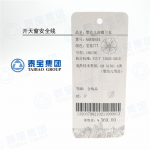
RFID + anti-counterfeiting application program in the clothing industry
[ad_1]
With the improvement of living standards, people’s demand for quality has become more and more obvious, and brand expression has become more and more personalized. Consumers prefer brands that they identify with when shopping. This is particularly evident in apparel, footwear and hat companies.
As we all know, RFID, a fast and efficient technology, solves the problems of fast clothing storage and accurate inventory inventory, saving a lot of labor costs.
However, on the market side, it is very difficult to intuitively identify traditional clothing products. The tags used in the products are usually very simple, without effective anti-counterfeiting functions, but simply marked with brand, model, size and other information, which is difficult for consumers to distinguish. Pseudo. Driven by profits, individual unscrupulous merchants counterfeit and sell fake branded footwear and clothing, and use brands and trademarks to capture high profits at extremely low production costs.
Take a well-known brand as an example. There are many sales channels, online sales platforms on cable, offline physical retail stores, and supermarkets are also selling. It is very difficult for enterprises to manage, but for consumers, it is inevitable to consume Troubled when shopping.
Aiming at these practical problems faced by enterprises, we can use tag products that combine anti-counterfeiting technology + RFID technology to solve them. The anti-counterfeiting technologies that can be used in the clothing industry are as follows:
The first is paper anti-counterfeiting. The anti-counterfeiting paper of the open skylight safety thread is half-buried in the paper with the brand name engraved in the paper making process. One section is exposed and the other section is buried in the paper. The distance is relatively accurate. This greatly raises the threshold for fraud.
Moreover, the use of this kind of technology on the RMB has a good foundation of public awareness and has been promoted by many media and financial institutions. It does not require consumer training. It is really a low-cost and effective security and anti-counterfeiting method.

(Buried into the security line on the back of the tag)
In addition, we can make a special edition paper unique to the brand by customizing the safety thread paper. This kind of special edition paper has a minimum order quantity, which shields some counterfeiters from the production scale.
The second type can be combined with digital anti-counterfeiting. Clothing companies can use the excellent anti-counterfeiting traceability platform in China, and identify them through the query portal provided by the platform, such as: WeChat official account, QR code scanning, 400 calls, mobile phone text messages, website query, etc.
The third is the special anti-counterfeiting technology anti-counterfeiting. Special anti-counterfeiting technology, through advanced production technology, to achieve the anti-counterfeiting characteristics of different products, such as temperature change ink technology, when the user puts his hand on the clothing label, the color of the tag changes due to temperature changes. While achieving the anti-counterfeiting effect, it also increases the interaction between the product and the user, optimizing the customer experience. Here, we chose the embossed hot stamping anti-counterfeiting with high aesthetics and strong practicability to use on the tag. So, why use this technique on hang tags?

(Real shot of laser holographic butterfly pattern)
Because the laser holographic area has brilliant colors, high-grade metallic luster and strong three-dimensional effect, as a first-line anti-counterfeiting technology, consumers can identify the authenticity by simple methods such as visual observation or touch with their hands. This is a popular anti-counterfeiting technology. . In addition, no special instruments and tools are required for identification. This first-line anti-counterfeiting technology is becoming more and more favored by manufacturers and consumers.
In short, the above several anti-counterfeiting technologies and RFID can be used in combination, or you can choose to use any personalized matching, making the tag more unique and in line with the characteristics of your own clothing brand, achieving the purpose of making consumers identify the true and false at a glance, so that they can rest assured Purchase, automatically check, and block fakes, so that apparel companies can easily maintain the product image created by the brand and enhance the product brand value.
Shandong Taibao Anti-counterfeiting Technology Products Co., Ltd. will debut soonIOTE 2018 10th International Internet of Things Expo · Summer Exhibition,July 31-August 2Meet you at Shenzhen Convention and Exhibition Center, The booth number is1A219, Welcome everyone to come to consult!
[ad_2]






